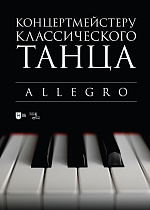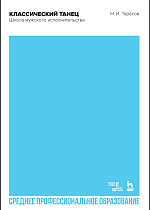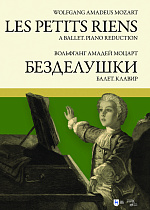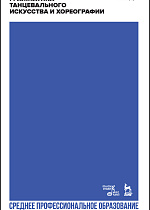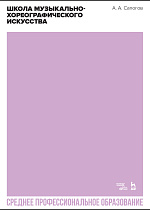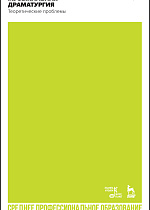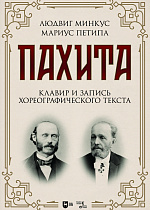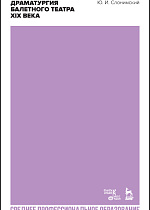Дуэтно-классический танец - все книги по дисциплине. Издательство Лань
Сохранить список:
Excel
Excel
Закрыть
Выгрузка списка книг доступна только авторизованным пользователям. Авторизоваться
В данном сборнике представлены произведения в жанре салонной музыки и оперетты периода с середины XIX века до 40-х годов XX. Наряду с популярными мелодиями известными каждому, в сборнике открываются страницы музыки малознакомой, редко исполняемой, но не менее очаровательной. Среди имен – Ф. Легар, И. Кальман, И. Штраус, А. Аренский, М. Мошковский, М. Регер, С. Шаминад, П. Уэкс, Э. Харрисон и многие другие. Все пьесы подобраны для сопровождения уроков балетного класса.
Издание адресовано концертмейстерам балетных школ, театров, хореографических коллективов, преподавателям хореографии и балетмейстерам-постановщикам.
The current collection presents the pieces in the genre of salon music and operetta written between the mid-19th century and 1940s. Along with popular melodies known to anyone, the collection gives the examples of rare pages of music, little known and not so often performed, but still full of charm. Among the names are F. Lehár, I. Kálmán, J. Strauss, A. Arensky, M. Moszkowski, M. Reger, C. Chaminade, P. Wachs, A. Harrison and many others. All the pieces are intended for accompanying the lessons of a classical ballet.
The edition is addressed to accompanists at ballet schools, theaters, choreographic groups, choreography teachers and choreographers.
Издание адресовано концертмейстерам балетных школ, театров, хореографических коллективов, преподавателям хореографии и балетмейстерам-постановщикам.
The current collection presents the pieces in the genre of salon music and operetta written between the mid-19th century and 1940s. Along with popular melodies known to anyone, the collection gives the examples of rare pages of music, little known and not so often performed, but still full of charm. Among the names are F. Lehár, I. Kálmán, J. Strauss, A. Arensky, M. Moszkowski, M. Reger, C. Chaminade, P. Wachs, A. Harrison and many others. All the pieces are intended for accompanying the lessons of a classical ballet.
The edition is addressed to accompanists at ballet schools, theaters, choreographic groups, choreography teachers and choreographers.
Данный сборник продолжает серию «Концертмейстеру классического танца». В сборнике представлены примеры музыкального оформления урока из раздела Allegro.
Издание предназначено для концертмейстеров училищ, школ искусств, любительских коллективов.
Издание предназначено для концертмейстеров училищ, школ искусств, любительских коллективов.
Книга «Классический танец. Школа мужского исполнительства» — переиздание труда Н. И. Тарасова, одного из корифеев педагогики в области балета. Это руководство для тех, кто занят обучением танцевальному искусству, охватывает все стороны педагогического процесса: основы классического танца, его цели и задачи, планирование работы педагога и учет успеваемости, эстетическое воспитание учеников, подбор музыкального материала для уроков. Работавший в годы советской власти, автор часто обращается к опыту советского балета, и издатели оставили текст без изменений из уважения к искусству, получившему всемирное признание.
Большая часть учебного пособия посвящена методике обучения танцу — позам, танцевальным движениям, прыжкам, поворотам в той последовательности и в тех сочетаниях, которые проверены опытом и обеспечивают усвоение всех, даже самых сложных движений классического танца.
Учебник предназначен педагогам и студентам средних специальных учебных заведений.
“Classical dance. Technique for the Male Dancer” is a re-edition of the work written by N. I. Tarasov, the coryphaeus of ballet pedagogy. The textbook provides recommendations for those learning dance art about all parts of pedagogical process: the basics of classical dance, its goals and objectives, planning of pedagogical work, record of academic achievements, aesthetic education of students, and selection of music material for lessons. The author, worked in the Soviet Union, often refers to the Soviet Ballet; publishers left this material with respect to internationally recognized art.
The textbook is designed to teachers and students of colleges.
The main body of the textbook is given over to dance teaching method — poses, movements, bounces, and twirls are presented sequentially, that helps to learn all, even difficult, dance steps.
Большая часть учебного пособия посвящена методике обучения танцу — позам, танцевальным движениям, прыжкам, поворотам в той последовательности и в тех сочетаниях, которые проверены опытом и обеспечивают усвоение всех, даже самых сложных движений классического танца.
Учебник предназначен педагогам и студентам средних специальных учебных заведений.
“Classical dance. Technique for the Male Dancer” is a re-edition of the work written by N. I. Tarasov, the coryphaeus of ballet pedagogy. The textbook provides recommendations for those learning dance art about all parts of pedagogical process: the basics of classical dance, its goals and objectives, planning of pedagogical work, record of academic achievements, aesthetic education of students, and selection of music material for lessons. The author, worked in the Soviet Union, often refers to the Soviet Ballet; publishers left this material with respect to internationally recognized art.
The textbook is designed to teachers and students of colleges.
The main body of the textbook is given over to dance teaching method — poses, movements, bounces, and twirls are presented sequentially, that helps to learn all, even difficult, dance steps.
Книга «Классический танец. Школа мужского исполнительства» — переиздание труда Н. И. Тарасова, одного из корифеев педагогики в области балета. Это руководство для тех, кто занят обучением танцевальному искусству, охватывает все стороны педагогического процесса: основы классического танца, его цели и задачи, планирование работы педагога и учет успеваемости, эстетическое воспитание учеников, подбор музыкального материала для уроков. Работавший в годы советской власти, автор часто обращается к опыту советского балета, и издатели оставили текст без изменений из уважения к искусству, получившему всемирное признание.
Большая часть учебного пособия посвящена методике обучения танцу — позам, танцевальным движениям, прыжкам, поворотам в той последовательности и в тех сочетаниях, которые проверены опытом и обеспечивают усвоение всех, даже самых сложных движений классического танца.
Учебник предназначен педагогам и студентам средних специальных учебных заведений.
“Classical dance. Technique for the Male Dancer” is a re-edition of the work written by N. I. Tarasov, the coryphaeus of ballet pedagogy. The textbook provides recommendations for those learning dance art about all parts of pedagogical process: the basics of classical dance, its goals and objectives, planning of pedagogical work, record of academic achievements, aesthetic education of students, and selection of music material for lessons. The author, worked in the Soviet Union, often refers to the Soviet Ballet; publishers left this material with respect to internationally recognized art.
The textbook is designed to teachers and students of colleges.
The main body of the textbook is given over to dance teaching method — poses, movements, bounces, and twirls are presented sequentially, that helps to learn all, even difficult, dance steps.
Большая часть учебного пособия посвящена методике обучения танцу — позам, танцевальным движениям, прыжкам, поворотам в той последовательности и в тех сочетаниях, которые проверены опытом и обеспечивают усвоение всех, даже самых сложных движений классического танца.
Учебник предназначен педагогам и студентам средних специальных учебных заведений.
“Classical dance. Technique for the Male Dancer” is a re-edition of the work written by N. I. Tarasov, the coryphaeus of ballet pedagogy. The textbook provides recommendations for those learning dance art about all parts of pedagogical process: the basics of classical dance, its goals and objectives, planning of pedagogical work, record of academic achievements, aesthetic education of students, and selection of music material for lessons. The author, worked in the Soviet Union, often refers to the Soviet Ballet; publishers left this material with respect to internationally recognized art.
The textbook is designed to teachers and students of colleges.
The main body of the textbook is given over to dance teaching method — poses, movements, bounces, and twirls are presented sequentially, that helps to learn all, even difficult, dance steps.
Свой единственный балет В. А. Моцарт сочинил, когда в сентябре 1777 г. останавли-вался в Париже. С просьбой создать балет к композитору обратился Ж. Ж. Новерр (1727–1810) — танцовщик, хореограф, теоретик и реформатор балета. Премьера в исполнении звездного состава состоялась 11 июня 1778 г. в Париже в Королевской академии музыки.
«Безделушки» («Les petits riens») были показаны при жизни Моцарта лишь несколько раз. На долгое время балет был забыт, однако в начале XX века возродился. Для балетмейстеров это произведение уже не содержит тех новаторских черт, которые были важны для первой постановки — балет стал историей, вызывающей интерес и вдохновляющей на новые прочтения классики.
Комический одноактный балет «Безделушки» — это прощание со старым стилем, прошлой стилистикой. Сюжет балета включает в себя три сцены-миниатюры. Сцена первая: пастушки ловят Купидона сетью и заключают в клетку. Сцена вторая: игра в жмурки. Сцена третья: Купидон заставляет двух пастушек ревновать третью, переодетую пастушком, но она раскрывает свой секрет. Заканчивается представление разнообразными фигурами.
W. A. Mozart composed his one and only ballet during his stay in Paris in September, 1777. It was J. G. Noverre (1727–1810), a dancer, choreographer, theorist and ballet reformer, who offered the composer to create a ballet. The all-stars premiere took place on June 11, 1778 in Paris at the Royal Academy of Music.
“The Little Nothings” (“Les petits riens”) was performed only a few times during Mozart’s lifetime. Since then, the ballet was forgotten for a long time, but it was revived at the beginning of the 20th century. This work contains no longer those innovative features for choreographers that were important for the first production, the ballet has become a history that arouses interest and inspires new interpretations of classics.
The comic one-act ballet “Les petits riens” represents a farewell to the old style, the stylistics of the past. The ballet plot includes three miniature scenes. Scene 1: the shepherdesses catch Cupid with a net and imprison him in a cage. Scene 2: game of blind man’s buff. Scene 3: Cupid makes two shepherdesses jealous of the third one, disguised as a shepherd, but she reveals her secret. The performance ends with diverse figures.
«Безделушки» («Les petits riens») были показаны при жизни Моцарта лишь несколько раз. На долгое время балет был забыт, однако в начале XX века возродился. Для балетмейстеров это произведение уже не содержит тех новаторских черт, которые были важны для первой постановки — балет стал историей, вызывающей интерес и вдохновляющей на новые прочтения классики.
Комический одноактный балет «Безделушки» — это прощание со старым стилем, прошлой стилистикой. Сюжет балета включает в себя три сцены-миниатюры. Сцена первая: пастушки ловят Купидона сетью и заключают в клетку. Сцена вторая: игра в жмурки. Сцена третья: Купидон заставляет двух пастушек ревновать третью, переодетую пастушком, но она раскрывает свой секрет. Заканчивается представление разнообразными фигурами.
W. A. Mozart composed his one and only ballet during his stay in Paris in September, 1777. It was J. G. Noverre (1727–1810), a dancer, choreographer, theorist and ballet reformer, who offered the composer to create a ballet. The all-stars premiere took place on June 11, 1778 in Paris at the Royal Academy of Music.
“The Little Nothings” (“Les petits riens”) was performed only a few times during Mozart’s lifetime. Since then, the ballet was forgotten for a long time, but it was revived at the beginning of the 20th century. This work contains no longer those innovative features for choreographers that were important for the first production, the ballet has become a history that arouses interest and inspires new interpretations of classics.
The comic one-act ballet “Les petits riens” represents a farewell to the old style, the stylistics of the past. The ballet plot includes three miniature scenes. Scene 1: the shepherdesses catch Cupid with a net and imprison him in a cage. Scene 2: game of blind man’s buff. Scene 3: Cupid makes two shepherdesses jealous of the third one, disguised as a shepherd, but she reveals her secret. The performance ends with diverse figures.
Переиздание фундаментального труда одесского преподавателя танцев А. Я. Цорна. Впервые вышедшая на русском языке в 1890 г., книга содержит подробное описание танцевальных упражнений, шагов и танцев второй половины XIX в. и является ценнейшим источником информации о социальном танце этого периода.
Книга снабжена подробными комментариями.
Учебное пособие предназначено педагогам и студентам средних специальных учебных заведений.
It’s a re-edition of a fundamental work of a dancing teacher A. Y. Tsorn from Odessa.
First published in Russian in 1890 the book contains a detailed description of dance exercises, steps and dances of the second half of the 19th century. It’s a valuable source of information about social dance of this period.
The book is provided with detailed comments.
The textbook is intended for teachers and stundents of colleges.
Книга снабжена подробными комментариями.
Учебное пособие предназначено педагогам и студентам средних специальных учебных заведений.
It’s a re-edition of a fundamental work of a dancing teacher A. Y. Tsorn from Odessa.
First published in Russian in 1890 the book contains a detailed description of dance exercises, steps and dances of the second half of the 19th century. It’s a valuable source of information about social dance of this period.
The book is provided with detailed comments.
The textbook is intended for teachers and stundents of colleges.
Автор книги — Анатолий Александрович Сапогов, выдающийся русский танцовщик и педагог, в прошлом солист Мариинского (Кировского) театра, заслуженный артист России, профессор СПбГУП.
В книге даются основы двух важнейших дисциплин: классического и народно-сценического танца. В пособии рассматриваются анатомические, физиологические и психологические закономерности образно-выразительных движений. Автор детально разбирает работу различ-ных групп мышц и рычагов аппарата танцовщика при исполнении им всевозможных танцеваль-ных движений; подробно объясняет, как, опираясь на знания законов биомеханики, научиться сознательно управлять своим телом в танце и добиться максимальной музыкально-сценической выразительности. Книга дополнена рисунками автора и нотным материалом.
Книга будет интересна педагогам и студентам средних специальных учебных заведений.
The author of the book Anatoly Alexandrovich Sapogov is an outstanding Russian dancer and a teacher, a former solo performer of Mariinsky (Kirovsky) theatre, a Distinguished Artist of Russia, a professor of Saint-Petersburg University of Humanities and Social Sciences.
The fundamentals of the most important subjects, which are classical and folk — stage dance, are presented in the book. Anatomical, physiological and psychological regularities of the imaginative expressive movements are described there. The author investigates in details the work of different grounds of muscles and instruments of a dancer’s apparatus while performing various dance movements. He explains how to learn to control your body in a dance consciously and to achieve maximum music scenic expression, basing on the knowledge of biomechanical rules. The book is supplemented by the author’s drawings and scores.
The book will be interesting for teachers and students of colleges.
В книге даются основы двух важнейших дисциплин: классического и народно-сценического танца. В пособии рассматриваются анатомические, физиологические и психологические закономерности образно-выразительных движений. Автор детально разбирает работу различ-ных групп мышц и рычагов аппарата танцовщика при исполнении им всевозможных танцеваль-ных движений; подробно объясняет, как, опираясь на знания законов биомеханики, научиться сознательно управлять своим телом в танце и добиться максимальной музыкально-сценической выразительности. Книга дополнена рисунками автора и нотным материалом.
Книга будет интересна педагогам и студентам средних специальных учебных заведений.
The author of the book Anatoly Alexandrovich Sapogov is an outstanding Russian dancer and a teacher, a former solo performer of Mariinsky (Kirovsky) theatre, a Distinguished Artist of Russia, a professor of Saint-Petersburg University of Humanities and Social Sciences.
The fundamentals of the most important subjects, which are classical and folk — stage dance, are presented in the book. Anatomical, physiological and psychological regularities of the imaginative expressive movements are described there. The author investigates in details the work of different grounds of muscles and instruments of a dancer’s apparatus while performing various dance movements. He explains how to learn to control your body in a dance consciously and to achieve maximum music scenic expression, basing on the knowledge of biomechanical rules. The book is supplemented by the author’s drawings and scores.
The book will be interesting for teachers and students of colleges.
В работе даются обобщающие, универсальные представления о феномене музыкальной драматургии, его функционировании в разных жанрах музыкального искусства. Эти представления способствуют усвоению необходимых теоретических знаний и развитию ценных практических навыков драматургического анализа. Учебное пособие адресовано студентам и педагогам средних специальных учебных заведений.
In this work the general, universal conceptions of the phenomenon of the musical dramaturgy and its functioning in different genres of music are given. These ideas contribute to the assimilation of the necessary theoretical knowledge and to the development of valuable practical skills of dramatic analysis.
The textbook is addressed to students and teachers of colleges.
In this work the general, universal conceptions of the phenomenon of the musical dramaturgy and its functioning in different genres of music are given. These ideas contribute to the assimilation of the necessary theoretical knowledge and to the development of valuable practical skills of dramatic analysis.
The textbook is addressed to students and teachers of colleges.
В предлагаемом читателям издании собраны материалы, связанные с балетом «Пахита». Это фортепианные переложения знаменитого Grand pas (включая четырнадцать вариаций, исполнявшиеся в разных вариантах его постановок), Pas de trois, Полонез-мазурка. Помимо нотного материала, читателю предлагаются записи хореографического текста этих номеров, либретто балета, иллюстративный материал.
Издание будет полезно практикам балетного театра (балетмейстерам, исполнителям, педагогам и учащимся хореографических учебных заведений, специалистам по классическому наследию русского балетного театра, концертмейстерам), его теоретикам (балетоведам, театроведам, музыковедам) и всем любителям балетного театра.
The сurrent edition contains materials related to the ballet “Paquita”. These are piano transcriptions of the famous Grand pas (including fourteen variations used in different stage versions), Pas de trois, Polonaise-Mazourka. In addition to the sheet musical material, the reader is offered notations of the choreographic text, the ballet libretto, illustrations.
The edition will be useful for ballet theater practitioners (choreographers, performers, teachers and students of choreographic educational institutions, experts in the Russian ballet theater classical heritage, accompanists), its theorists (ballet experts, theater experts, musicologists) and all ballet theater lovers.
Издание будет полезно практикам балетного театра (балетмейстерам, исполнителям, педагогам и учащимся хореографических учебных заведений, специалистам по классическому наследию русского балетного театра, концертмейстерам), его теоретикам (балетоведам, театроведам, музыковедам) и всем любителям балетного театра.
The сurrent edition contains materials related to the ballet “Paquita”. These are piano transcriptions of the famous Grand pas (including fourteen variations used in different stage versions), Pas de trois, Polonaise-Mazourka. In addition to the sheet musical material, the reader is offered notations of the choreographic text, the ballet libretto, illustrations.
The edition will be useful for ballet theater practitioners (choreographers, performers, teachers and students of choreographic educational institutions, experts in the Russian ballet theater classical heritage, accompanists), its theorists (ballet experts, theater experts, musicologists) and all ballet theater lovers.
Данная книга представляет собой историко-теоретическую разработку проблем балетной драматургии XIX века. Она содержит большой разнообразный материал – сценарии, либретто классических балетов позапрошлого столетия, в также авторский комментарий. Эта книга вооружит балетмейстеров знанием первоисточников классических спектаклей, которые явились основой развития хореографического движения в XX веке, поможет им, опираясь на классическое наследие, создавать новые современные произведения. Соответствует современным требованиям Федерального государственного образовательного стандарта среднего профессионального образования и профессиональным квалификационным требованиям.
Книга адресована студентам и педагогам средних специальных учебных заведений.
This book represents a historical and theoretical development of issues of a ballet drama of the XIX century. It contains a vast and various materials, i.e. scripts, libretti of classical ballets of the XIX century, as well as the author's comments. This book will equip the choreographers with the first-hand knowledge of classical performances, which were the basis for the development of choreographic movement in the XX century, it will help them to create brand new contemporary works on the basis of the classical heritage. Corresponds to the modern requirements of the Federal State Educational Standard of Secondary Vocational Education and professional qualification requirements.
The book is addressed to students and teachers of colleges.
Книга адресована студентам и педагогам средних специальных учебных заведений.
This book represents a historical and theoretical development of issues of a ballet drama of the XIX century. It contains a vast and various materials, i.e. scripts, libretti of classical ballets of the XIX century, as well as the author's comments. This book will equip the choreographers with the first-hand knowledge of classical performances, which were the basis for the development of choreographic movement in the XX century, it will help them to create brand new contemporary works on the basis of the classical heritage. Corresponds to the modern requirements of the Federal State Educational Standard of Secondary Vocational Education and professional qualification requirements.
The book is addressed to students and teachers of colleges.
Закрыть
Сообщить о поступлении
Укажите ваш e-mail, и мы пришлем уведомление, как только книга
станет доступна для покупки.



